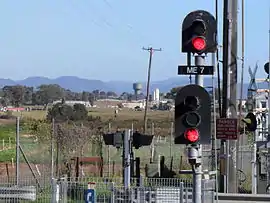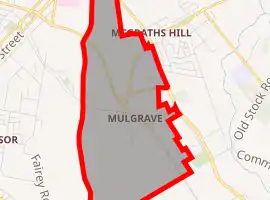Mulgrave, New South Wales
Mulgrave is a suburb north west of Sydney, in the state of New South Wales, Australia. It is a predominately industrial and commercial area.[2]
| Mulgrave New South Wales | |||||||||||||||
|---|---|---|---|---|---|---|---|---|---|---|---|---|---|---|---|
 View towards Windsor and Blue Mountains, from Mulgrave railway station | |||||||||||||||

| |||||||||||||||
| Population | 92 (2016 census)[1] | ||||||||||||||
| Postcode(s) | 2756 | ||||||||||||||
| Location | 53.5 km (33 mi) from Sydney CBD | ||||||||||||||
| LGA(s) | City of Hawkesbury | ||||||||||||||
| State electorate(s) | Hawkesbury | ||||||||||||||
| Federal Division(s) | Greenway | ||||||||||||||
| |||||||||||||||
History
Lieutenant Governor Francis Grose called the district near the present Pitt Town on which he settled the first 22 settlers 'Mulgrave Place' in honour of his friend Lord Mulgrave whose patronage he had enjoyed in England.[3][4]
Transport
Mulgrave railway station is on the T1 North Shore & Western line and the T5 Cumberland line. It is four stations from the terminus station at Richmond. Mulgrave station is 53 kilometres (33 mi) from Sydney's Central Station, which takes approximately 1 hour 6 minutes to travel by train during peak hour.[5] The station along with the arrival of a steam train features in the 'The Seekers at Home' TV special, 1968. Filmed as the setting for the song 'Angeline is always Friday', steam hauled services ceased to operate shortly afterwards.
Demographics
Mulgrave's population is 92 (Census 2016).[2] It had a median weekly household income of A$2,062, which is 143.4% above the national average.[6]
References
- Australian Bureau of Statistics (27 June 2017). "Mulgrave (NSW) (State Suburb)". 2016 Census QuickStats. Retrieved 19 March 2018.

- "2016 Census QuickStats: Mulgrave (NSW)". quickstats.censusdata.abs.gov.au. Retrieved 28 October 2018.
- http://www.hawkesbury.org/?c=source&source_id=386
- "NSW Railway Station Names and Origins". Nswrail.net. 21 March 1999. Retrieved 6 July 2012.
- "NSW Trains Trip Planner". Transport NSW.
- "2016 Census QuickStats: Australia". quickstats.censusdata.abs.gov.au. Retrieved 28 October 2018.